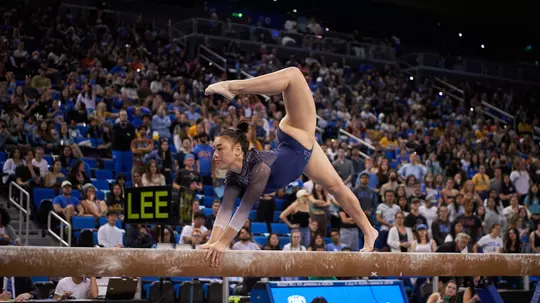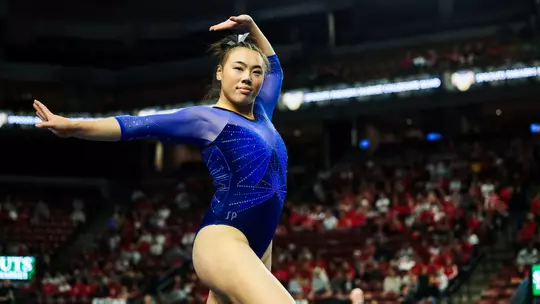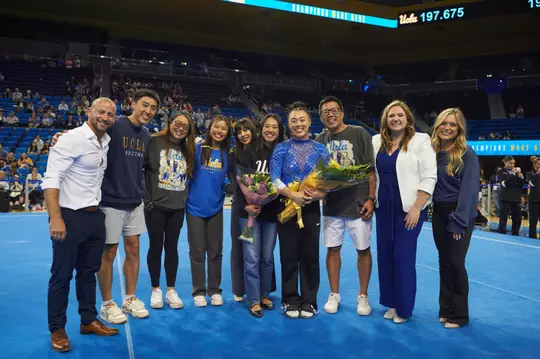Steady as She Goes
Gymnast Emily Lee finds balance in both life and sport.
The following story ran in the Winter issue of Bruin Blue Magazine.

By Jon Gold
Before they start their dance, Emily Lee shares an intimate moment with the balance beam. They are not adversaries but friends. There is no concept of conquering the beam or owning the beam. It’s a partnership, gymnast and apparatus, one fluid and one solid, one in permanent motion and one stuck to the floor.
Just before the balance beam portion of a UCLA gymnastics meet, the Bruins will have a few minutes to get acquainted with it, to pick up on its personal and unique characteristics.
If balance beams could speak, they’d all have a different voice. They are all slightly different in subtle ways, a soft spot here, a hard spot there. Knowing the beam deeply can be the difference between the thinnest of margins.
So that first hello goes a long way. Lee approaches and kisses her hand and touches the beam and gently whispers, “Please be nice to me.”
“It’s a reminder that we’re friends,” she said. “I won’t physically put my lips on the beam, because that’s disgusting.”
OK, so there are limits.
But theirs is a symbiotic relationship. What is Lee without the beam? What is the beam without Lee?
“For me, it’s like I’m trying to move with it,” she said. “Every beam can feel a little different. Some stiffer, some bouncier. The beam is going to be the beam, but you have to adjust to whatever it gives you.”
Lee is the Bruins’ leadoff hitter, its table-setter. She’s always the first up for UCLA on the beam. It’s a pressure-packed position for any gymnast, with a razor-thin margin for error.
And every time, she handles it with grace.

My team trusts me so much, so much more than I trust myself a lot of the time.Emily Lee
Emily Lee can tell you about pressure.
It was early this season, and Lee had the wobbles.
You think the balance beam is easy? OK, go ahead and flip backwards on the ground. Hard enough. Now do it while teeter-tottering on a four-inch wide beam, four feet up from the ground.
There is almost no such thing as perfection. It’s almost not even a goal.
And it’s scored that way, too: In the long and incredible history of UCLA gymnastics, only one athlete - Grace Glenn in 2020 - has ever led off a beam rotation with a perfect 10.
It’s the only time in NCAA history, too.
Why is it so rare? Because judges, though they’re not supposed to, often grade with context. They may not have seen anyone else perform that day — how can they possibly measure perfection? Better to set the bar low and force later gymnasts to measure up. Start off with a 10 and who knows how many 10s will be doled out?
Lee has to settle for near-perfection, and that’s when everything goes well. In her first three years as the Bruins’ leadoff gymnast on beam, Lee averaged a 9.844 and scored 9.900 or higher 15 times in 27 meets (56 percent of the time). Her career-best score is 9.950, which she has hit twice. Going into the 2025 postseason, she has hit all 104 routines in her career without a fall, with her only sub-9.6 score coming in her first meet. And she didn’t even fall then, as her score was lowered because of a missed combination.
“When we’re building our lineup, the leadoff spot is really crucial,” UCLA coach Janelle McDonald said. “It sets the tone. If you go out and are confident and are aggressive, it creates a belief in the lineup. You want someone steady in their approach. In the balance beam, there is a very small margin for error. Having someone who is steady and confident in the role matters.”
Someone who’s made for it, even.
“She’s what we call a beamer,” McDonald said. “Some people just are naturally more comfortable four feet in the air, four inches wide.”
But even a natural sometimes falters. And it’s in times like this the Bruins pick her up.
“My team trusts me so much, so much more than I trust myself a lot of the time,” she said. “That’s why I never feel like if I mess up, they’re gonna hate me. This last meet in Pauley, I had a wobble, I didn’t start the way I wanted to and I felt that burden on my shoulders. Our Director of Ops Haley Gonzalez pulled me over and said your teammates have your back. It made me so emotional. They did have my back that day.
This was one mistake, one meet and it wasn’t my best, but I still fought for the team. I had some mistakes but I tried to not give them anything. They ended up having to count my score anyways. It’s a good reminder, yes there’s a lot of pressure on me, but it’s not all on me. It’s spread out throughout the whole lineup.”

Pressure? Pressure she can handle.
It was the thick of the COVID-19 pandemic, and businesses of all kinds across the country were faced with dire straits. But Lee was at the height of her budding gymnastics career, and it was all hands on deck.
Before COVID, with her home gym thriving, her coaches were able to travel with her. Not every gymnast gets this treatment. Then again, not every gymnast is an Olympic contender with her sights set on UCLA.
It was important to Lee that she had all the support she needed. Her parents helped out as much as they could, and her coaches, too. But there are limits.
So Lee hopped in her car, scrolled to Instacart and found a gig. Shopping at CVS for antacids isn’t the most thrilling of part-time jobs but Lee was a pro.
“There was this one order that was the best order of my life,” she said. “I had to go to PetSmart, pick up a couple toys and a bag of dog food. They tipped me 70 bucks. Most memorable order I had.”
And $70?
“That’s like a third of a flight right there.”
In the high-stakes, high-dollar world of elite gymnastics, this isn’t a typical story.
“For me, it made me very grateful,” Lee said. “It humbled me. It made me see the world in a different outlook. I realized how privileged I am all the time. I remember coming to college and seeing the gym, I didn’t have to buy grips any more. That was crazy for me. Having training, having doctor’s appointments, having a locker room that’s this size. You don’t take that for granted. Having team managers move your mats. In club, you’re on your hands and knees moving mats, duct taping mats. Every time here, the mats are back in the same place.”
Everyone handles pressure differently. But in those days, with her career on the line, Lee was willing to go great lengths to succeed. No matter the price of gas.
“Pressure is privilege, too,” she said. “I’ve learned that a lot.”

Pressure is privilege, too. I’ve learned that a lot.Emily Lee
Lee has been forced to learn that lesson time and time again. And in the hardest of ways.
Pressure isn’t the balancing act of college athletics. Pressure isn’t the balance beam itself. Pressure isn’t trying to raise money for coaches to fly to gymnastics meets.
Pressure is trying to hold it together when your baby sister faces the fight of a lifetime.
Taylor Emma Lee was just a little girl when she was diagnosed with leukemia. It is the most common cancer in children, accounting for nearly 30 percent of all childhood cancers. Because of medical enhancements over the last three decades, now 90 percent of children with leukemia survive their battles.
Taylor Emma Lee was part of the 10 percent. She had a smile that spanned two buildings and precious eyes. She died on a Saturday. The Lee family was devastated.
Emily Lee, who was nearly 13 when her little sister died, was angry at the world. And her sport. And herself.
“When she died, I really hated the sport,” Lee said. “I couldn’t get over the guilt that I spent so many hours in the gym. At what cost. I sacrificed so many memories with her, so much time with her. Time I couldn’t get back. That’s something I have to live with.”
She lives with it to this day.
“I’ve done a lot of reflecting,” she said. “Why would I ever want to do this sport again? At that time, I only saw what it took from me, rather than what it gave me. But I started using (gymnastics) as a distraction, an escape from my problems. It’s like a cloud - no, it’s the sunglasses that protect you from what’s really going on in the world.”
It’s almost a decade now since little Taylor passed. The anniversary is going to be tough. Emily doesn’t talk about it much, but when she does, she often strikes to the heart of her teammates.
“She doesn’t mention Taylor too much with the team, but I know everything that happened,” said her teammate and best friend, Emma Malabuyo. “If anything, every year she has a tradition that she writes things and tells Taylor and puts it in a balloon and lets it fly away.”
In other ways, Emily carries Taylor with her everywhere she goes. Emily is interested in a career in medicine primarily because of what her younger sister went through.
“With my teammates, especially Emma, we always say to each other, ‘We’ve been through worse,’” Emily said. “This is nothing compared to life. We’ve overcome so much, we can overcome this. I had a really bad cold this week, fever before the meet. I felt [awful]. But it didn’t matter because I’ve felt [awful] before. Yeah I might have complained a little bit, but I still got it done.
“We always say to each other, ‘If I can get through this, I can get through anything.’”



